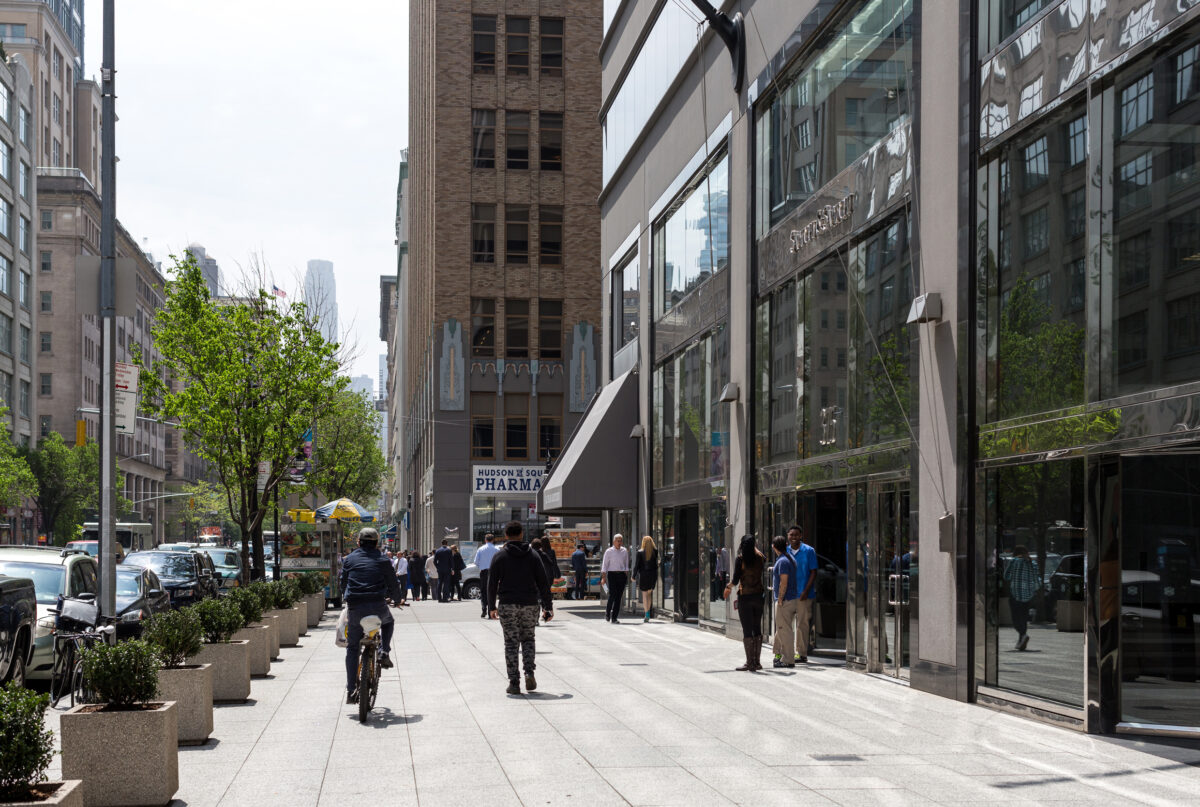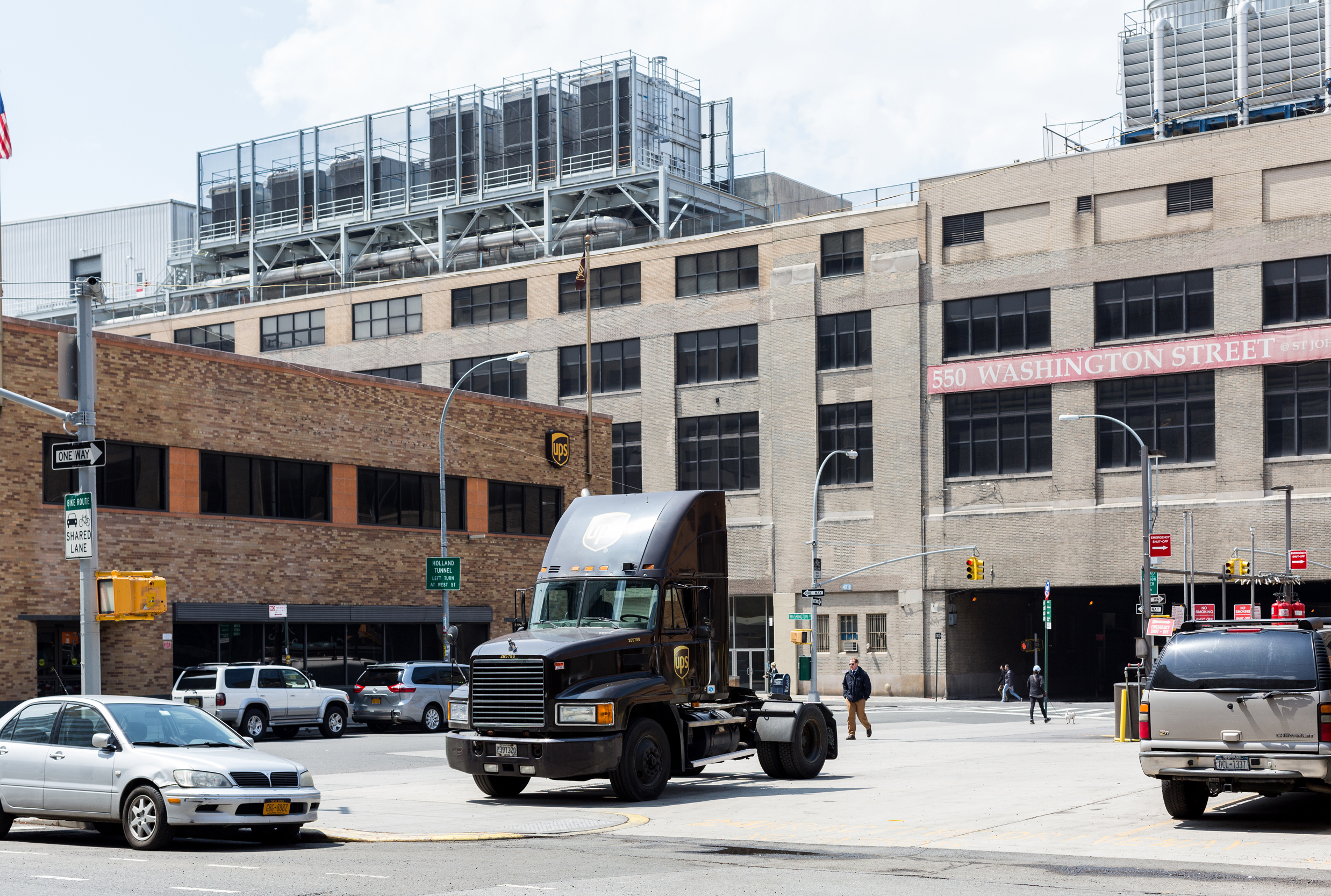Perched on colossal ottomans in the New York City headquarters of global ad agency Saatchi & Saatchi, Blake Enting and Marc Thorpe are surrounded by shapes that appear to be suspended in mid-air.
On closer inspection, however, are a varied assortment of everyday objects—a boombox, a bowtie, a telephone—arranged on the wall behind them to mimic the company’s signature ampersand.
The symbol befits the conversation at hand, and seems appropriate given the nature of the partnership between Business Design Director (and New Zealand native) Blake, and Marc, who runs an eponymous design studio and joined the company as Creative Director of Spatial just under two years ago. Sitting beside the makeshift ampersand, the pair reflect on artistic growth, innovation, and boldly going where no creative team has gone before. One key to said boldness, you might wonder? Imagination—and a healthy disregard for non-constructive criticism. “Put your work out there,” says Blake, “and let it do what it’s going to do.”
“I think one of the lessons that I’ve held onto from my design school days is, don’t put creativity in a box.”
-
A big question to start: How experiential does a brand need to be when everyone is constantly on their phones? What does space look like when screens dictate so much of our interaction with the physical world?
Blake Enting: Well, we may well be able to create stores where everything is on a screen and you have no physical product, but I’m not sure you’d want to do that. You want to be able to actually pick things up and have some sort of experience. However, we partner with companies who want to create screen-based stores and Saatchi, in its broader sense, has the capability to do some of those things.
I think one of the lessons that I’ve held onto from my design school days is: don’t put creativity in a box. Maybe things are changing across the whole creative industry, it doesn’t matter—why can’t you design a product if you’re a graphic designer? Why can’t you do graphics if you’re a product designer? Sure, you spend your time focusing on certain things you’re better at, but there’s this crazy need to put people in boxes. Breaking down those barriers, I think, is really advantageous because it enables people to unlock their creativity. I’m encouraging the team, here and where we can around the whole global network, to take on projects that traditionally we wouldn’t have taken on. I remember the very first time we did an interior job. We had a fashion designer come to us and she wanted a store design—she wanted branding work done and part of that project was the design of a store. She was going to engage a separate company for that and we said, “Well, we can do that.” -
Did you have anything in your portfolio to show her?
B: No. We’d never done interiors in our lives. But it was like, ‘what’s the worst that could happen?’ She says she doesn’t like it, and she goes and gets someone else to do it, right? So we put something on the table and she loved it and we ended up doing it. And, there was a bit of trial and error through that process. But you know, nothing’s impossible. Take the brakes off your thinking.
There was another great example of that late last year just after Marc joined us. We did a big campaign for Walmart which was Greenlight a Vet, raising awareness of the role that veterans play in society once they’ve stopped being in service. We ended up creating an interactive social piece. There was a physical object installation on Fifth Avenue that had a live feed to Facebook and Twitter. Marc jumped in and designed the whole spatial experience for that—a very 2001-esque obelisk with a counter on it. That’s just a great example of somebody going, ‘How do we take this offline and create an integrated experience that has some physicality to it?’ Something that people could walk into, take photographs and re-share? It’s creating this ecosystem of content that has a physical component.




“Nothing’s impossible. Take the brakes off your thinking.”
-
How do you create or facilitate that kind of boundary-less thinking? How do you motivate your team to think in that way?
B: Part of that is giving people permission to fail. You won’t get judged for trying something and having it not work. Part of it is also having flexibility in terms of how jobs are run, where you’re not trying to account for every single hour that you’ve spent. If the restraints on a job are such that you just have no flexibility, you can’t innovate outside of that.
Oftentimes it’s just going after hours like, ‘Hey, look, guys. If you want to give it a crack, give it a crack. We haven’t got any budget for this, but wouldn’t it be exciting if we did?’ And more often than not, it’s not stuff that clients are asking us to do. So you’re constantly pitching. You’re innovating on their behalf. And then trying to inspire them to get behind it, which, I’m not sure what that acceptance rate is—maybe 50/50? And, you know, this is true for graphics projects as much as product or spatial projects. Our ability to do that now with product information is, of course, remarkably enhanced with Marc on board because he’s an expert in that.
We rebranded Lenovo last year, the biggest laptop company in the world. That was a case where we pitched an idea to them. We were talking with them about something completely separate and the global CMO, David Roman, asked, ‘What would our brand look like, and what would our logo look like today if you had to make it an internet brand, something that was dynamic?’ And we came back a day later with a very, very rough concept, but it framed the idea of the logo being simplified down typographically so it’s more readable, but having a containment device that allowed it to be constantly updated and changed. They really liked it. It started a conversation, and then suddenly, we’d rebranded them. And it looked good, it launched, and has done very well for their business. There was good and bad feedback online, though—and, you know, when you read some of the bad reviews you’re like, ‘I’m giving up! I’m never designing again!’
-
But, then you do.
B: Well you’ve got to pay the bills. Years ago, there was a great documentary on Frank Gehry, which opened with him talking about how whenever he gets a new job, he’s filled with anxiety. And he usually tidies his desk and calls meetings he doesn’t need to have, and essentially procrastinates because he’s thinking, ‘Am I going to be good enough? Can I rise to the occasion?’ And it was really heartening to hear this icon say that, because that’s how it feels. Each time: ‘Is it going to be any good or is it going to be crap? Am I going to be derided in the press? Or, even worse, not written about at all?’ I don’t think you should read reviews. Put your work out there and let it do what it’s going to do.


“I don’t think you should read reviews. Put your work out there and let it do what it’s going to do.”
-
That’s probably a good perspective to have in the long run.
B: Particularly now. Every designer you talk to says the same thing: budgets are tighter, and timelines are not just shorter, they’re ridiculous. We’re getting two days now to do something that used to take two weeks, or even two months in some cases. People want to see a brand designed and turned around in two days. Which is insane. But there’s this instant gratification mentality in the market so saying no isn’t an option. If you say no, then you don’t have any clients. So you say yes, but the way you approach it is you just do stuff, put it on the table and then change it. You’re constantly prototyping.
-
In terms of ideation to execution, are projects only in development when a client comes to you, or are you constantly working on devising new objects—weird things that haven’t been invented yet?
B: Yeah, we do, weird is the word.
M: There’s never a stopping point. There’s always an idea. The question is just how quickly can we produce it. So it’s nice having relationships like the one we have with OTHR, where you can present those ideas directly.




“There’s never a stopping point. There’s always an idea. The question is just how quickly can we produce it.”
-
Speaking of OTHR, 3D printing: is it the future?
B: Well, it certainly has a future. I think the principle that OTHR is looking at is not so much 3D printing, but a business model that’s anchored around bringing design back to the fore in a way that’s sustainable. You don’t have to just work out how something can be mass produced. You can make one. Which is great because with some ideas, you probably shouldn’t make more than one.
M: For me, the sustainability factor is really interesting. Instead of having to produce mass quantities of an object and just hope they’ll sell, you essentially can order just one. It only exists based on the necessity of—or desire for—that one object. I think that’s really important. Additive manufacturing is essentially the next industrial revolution. Everything is going to be rapid prototyped that way, from the engine components that’ll go into a plane all the way through printing out your table and chairs and the objects that surround you. In the next 20 years, everything is going to be catered to you.
B: The other big part of that, I think—which is really important in countries like New Zealand, where I’m from—is that you’re removing the distribution channel. You can design something down there, 12,000 miles away, and you can print it out right here. All you need is the file. You’ve just taken out almost the largest cost of the manufacturing process, which gives more money back to the designers. Which is a good thing, because then they can create more.
M: It reduces the energy footprint, in terms of moving stuff around. We’re all going to have a printer at home that will allow us to rapidly prototype the things that we need. Like nails, for example—you can just hit print and you’ve got the 20 nails that you need.
-
But would you need the materials necessary to make those nails?
B: Well, you can print in pretty much any material, I think.
-
Let’s take the paperweight and the letter opener you produced for OTHR. What are they made out of?
M: Currently, ceramic and steel. Right now, it’s a dialogue you have to have with the manufacturer. We’re not just dictating; we have to take their recommendations, their minor edits, in regards to what direction we need to go. We have to trust.

